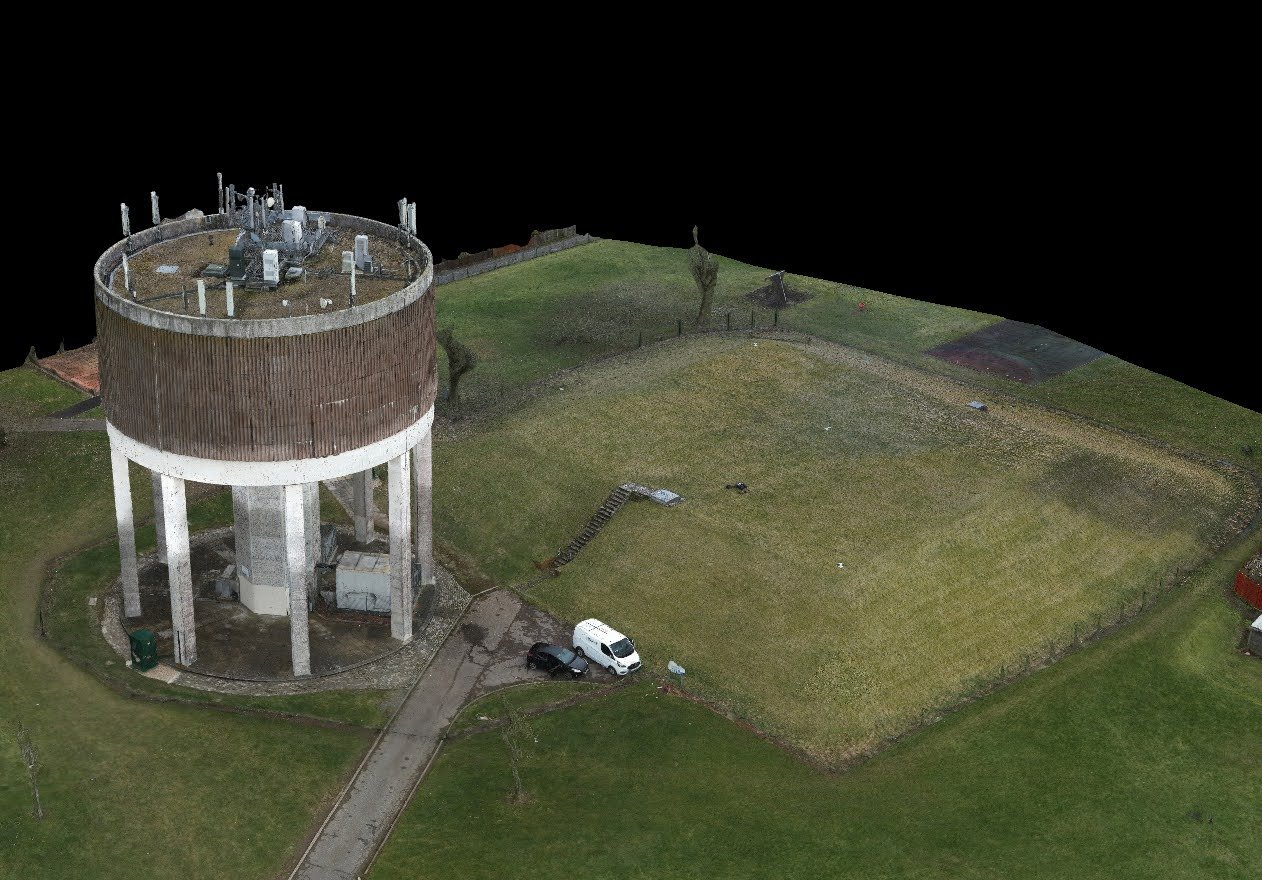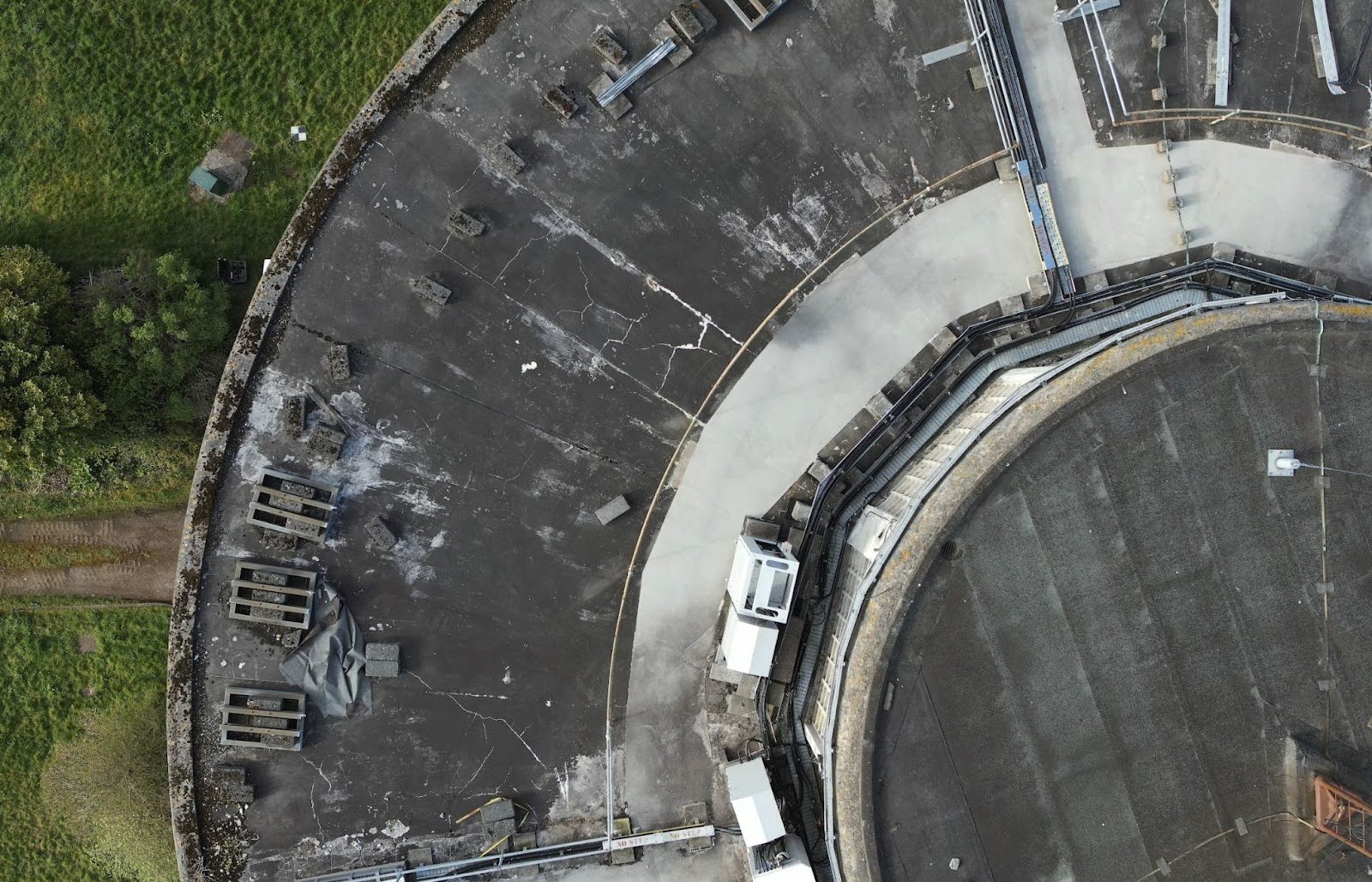Digital Twin Creation of Water Towers
Overview
Team UAV undertook a groundbreaking project in Scotland, focused on inspecting and creating digital twin models of water towers using photogrammetry. This project was aimed at utilising advanced drone technology to capture detailed images and data, which were then used to create accurate digital replicas of the water towers. These digital twins were intended to assist in maintenance planning, structural analysis, and long-term preservation strategies.
The Challenge
In the course of the project to inspect and create digital twins of water towers in Scotland, Team UAV encountered a complex array of challenges, each demanding a professional and strategic response. The uniqueness of each water tower, with its own architectural and historical characteristics, required a detailed and customised approach to ensure accurate digital replication.
Diverse Structural Complexities: Each water tower presented unique architectural features and structural complexities, necessitating tailored inspection strategies for accurate data capture.
Harsh Weather Conditions: Scotland's unpredictable and often harsh weather posed significant challenges, requiring flexibility and resilience in planning and execution.
Data Precision and Detail: The creation of digital twins for the water towers necessitated the capture of extremely high-resolution data and precise imaging, a process integral to accurately reflecting their structural integrity and detailed architecture. A key aspect of this process was ensuring adequate overlap in each captured image. This overlap was crucial for effective photogrammetric processing, allowing for the accurate stitching of images and the creation of a cohesive and detailed digital model. Furthermore, the comprehensive capture of the towers from every conceivable angle was imperative.
This exhaustive approach ensured that the digital reconstructions were not only complete but also true to the original structures in every aspect. Such meticulous attention to detail in data acquisition was pivotal in achieving the level of precision required for these sophisticated digital
twins.
Operational Efficiency in Remote Locations: Many water towers were located in remote or
difficult-to-access areas, posing logistical challenges in deploying equipment and personnel. Team UAV adopted a system of pre-planning and reconnaissance, where potential logistical hurdles were identified and addressed in advance. This proactive approach allowed for swift mobilisation and demobilisation of operations, minimising downtime and maximising productivity on site.
Operating in Built-Up Areas: A notable challenge was the operation around water towers located in urban settings. Here, the paramount concern for Team UAV was to safeguard the public and protect the surrounding properties. To effectively manage this, the team implemented meticulous risk mitigation strategies and ensured strict adherence to all relevant regulations. Engaging proactively with local homeowners was a crucial part of this process.
Team UAV prioritised open communication, ensuring that the residents' concerns were not only heard but also addressed comprehensively. This engagement, coupled with a rigorous compliance to regulations, was instrumental in building trust and cooperation, facilitating a smoother operation. By taking these proactive steps, Team UAV not only adhered to the highest safety standards but also fostered positive community relations, ensuring the project proceeded with minimal disruption and maximum local support.
The Solution
In addressing the project's unique requirements, Team UAV developed a comprehensive and methodical approach, underpinned by professional expertise and technological innovation. This strategy was crafted to not only address the complexities inherent in digitising Scotland's water towers but also to navigate the logistical and environmental challenges effectively.
The cornerstone of the solution was a meticulously planned inspection protocol, customised for each water tower. This involved a detailed assessment of the structural features and surrounding environments of the towers. Understanding these nuances was crucial to ensure that the drone operations were both efficient and effective, capturing the necessary data without compromising on safety or accuracy.
Incorporating advanced technological solutions was another key aspect of the approach. The use of state-of-the-art drones equipped with high-resolution cameras and 3D scanning technology was pivotal. These tools enabled the team to capture detailed images and data essential for creating accurate and comprehensive digital twins.
Moreover, the team's strategy included robust contingency planning to mitigate the challenges posed
by Scotland's unpredictable weather. This proactive approach ensured that data collection was not only consistent but also maintained the highest standards of quality and precision, irrespective of environmental conditions.
In summary, Team UAV's solution was a blend of careful planning, advanced technology, and adaptive strategies, all directed towards successfully creating digital twins of water towers in Scotland. This professional and thorough approach underlined the team's commitment to delivering high-quality results, reinforcing their status as a leader in innovative drone solutions.
Customised Inspection Protocols: For each water tower, a customised inspection plan was developed. This involved a detailed analysis of the structure to determine the most effective inspection routes and techniques.
Weather-Resilient Operations: The team employed weather-resilient drones and adapted their schedules to accommodate the unpredictable Scottish weather, ensuring reliable data collection without compromising safety.
Advanced Imaging Technology: The drones were equipped with state-of-the-art imaging technology, capable of capturing ultra-high-resolution images and 3D scanning data. This was crucial in creating detailed and accurate digital twins.
Remote Operation and Data Management: Utilising remote operation capabilities, the team efficiently managed the logistical challenges of working in remote areas. Data was processed and analysed remotely, enhancing operational efficiency.
Conclusion
The project was successfully completed, with significant achievements in both technology application and operational efficiency.
The creation of digital twins for the water towers was achieved with remarkable accuracy, providing invaluable assets for maintenance and structural analysis. The high-resolution imaging and detailed 3D modelling facilitated a level of insight into the water towers' conditions that was previously unattainable.






